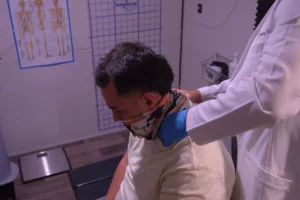
In many cases, people are unaware that they have scoliosis and do not know how to identify it until the curvature becomes more pronounced.
But how can you identify it early and what to do if you detect it? In this article we explain the symptoms, how to identify scoliosis in children and adults, and what steps to take if you think you have this condition.
What is scoliosis and how does it originate?
Scoliosis is an abnormal curvature of the spine. Although our spine has natural curvatures, when these are excessive or deviate to one side, it is considered scoliosis.
This deviation can occur in any part of the spine, but is most common in the thoracic or lumbar area.
There are several types of scoliosis, such as idiopathic scoliosis, which develops without a clear cause, or structural scoliosis, when there are malformations in the vertebrae.
Scoliosis symptoms: What signs should you look for?
Detecting the symptoms of scoliosis is critical to treating it early. The most common signs include:
- Visible deviation of the spineObserve if the back has a curvature to one side. This is more evident when the person leans forward.
- Shoulder asymmetryIf one shoulder is higher than the other, it may be a sign of scoliosis.
- Back painAlthough not all people with scoliosis experience pain, some may experience discomfort in the lower back or thoracic area.
- Hip imbalanceIf one hip appears to be higher than the other, it may indicate a curvature of the spine.
If you notice any of these symptoms, it is important to consult a professional for a proper diagnosis.
How to identify scoliosis in children and adults
Scoliosis can appear at any stage of life, but is most common during adolescence, when the spine is still developing.
In children, scoliosis can be difficult to identify at first, as they often have no pain. Here are some tips on how to detect it:
- In children: Performs the Adams testA simple test in which the child leans forward so that the back is parallel to the floor. If you observe that one part of the back rises more than the other, it could be a sign of scoliosis.

- In adultsAlthough scoliosis is more common in children, it can also develop in adulthood, especially due to factors such as incorrect posture or aging.
If you experience chronic pain or feel that your spine is misaligned, it is important to consult a specialist.
What to do if you have scoliosis and how to identify scoliosis?
If you suspect you have scoliosis, the first thing to do is to see a doctor. Depending on the severity of the curve, treatment options may vary:
- Mild scoliosisIf the curvature is small (less than 20 degrees), in many cases, an active lifestyle and strengthening and stretching exercises may be sufficient to prevent the curvature from worsening.
- Moderate scoliosis: Between 20 and 40 degrees, the use of a support or brace may be recommended to slow the progression of the curvature as the body continues to grow, especially in adolescents.
- Severe scoliosisIf the curvature exceeds 40 degrees, it may be necessary to consider more invasive options, such as surgery.
Detects the scoliosis on time
Identifying scoliosis early can make a big difference in treatment and prevent future complications. If you are a parent, regularly check your children's posture and do not hesitate to consult a doctor if you notice anything irregular.
In adults, staying active, stretching and maintaining good posture are key to preventing scoliosis from worsening.
Remember that prevention is key. Early detection and proper treatment can make a big difference in quality of life. If you have any concerns, do not hesitate to seek professional help.




